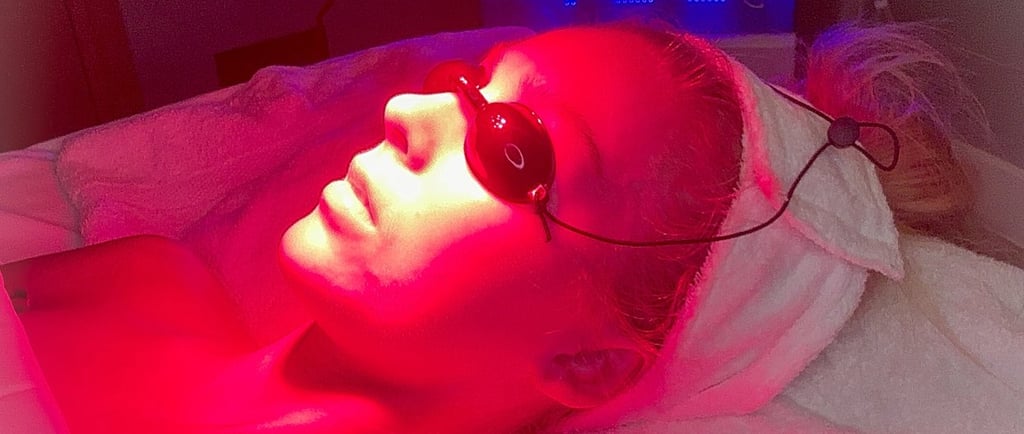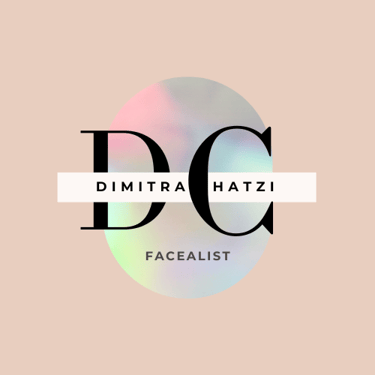How Red Light Therapy Can Transform Your Face:The Secret to Flawless Skin
Red light therapy offers numerous benefits for the skin, particularly for the face. By penetrating deep into the skin, red light therapy stimulates cellular energy production, increases blood circulation, reduces inflammation, and improves collagen production. This powerful combination helps to reduce the appearance of fine lines and wrinkles, improve skin tone and texture, and promote healing for conditions such as acne, rosacea, and sun damage. With its non-invasive nature and proven results, red light therapy is a game-changer for anyone looking to improve their skin's health and appearance.
WELLNESS TREATMENTS SCIENCESKIN EDUCATION
11/30/20236 min read
Red light therapy is a safe and effective way to achieve glowing skin. This natural treatment utilizes low-level red light wavelengths to deeply penetrate the skin, providing numerous benefits for both the face and body. By stimulating the production of ATP, the energy source for cells, red light therapy enhances cellular energy production. This, in turn, improves circulation, allowing vital nutrients, oxygen, and antioxidants to be delivered to the skin. The result is a reduction in inflammation and a promotion of healing. With just one session of red light therapy, you can experience the transformative effects of increased cellular energy and enjoy radiant, healthy skin.
What Is Red Light Therapy?
Did you know that red light therapy, a type of treatment that uses red light to promote healing, was discovered during space exploration? During an experiment on plant growth in space, astronauts noticed that scratches on their hands healed faster under red light. This led to many years of research by NASA and ultimately the discovery that red light therapy can be used as a form of photomedicine, which is the use of light to promote health and healing.
Red light therapy involves exposing an area of the body to a specific wavelength of red light, emitted by a device that can be held in your hand or cover your whole body. This red light stimulates your cells to work better, which can help with healing and improve overall health. It's pretty amazing how something discovered in space can have such a positive impact on our health here on Earth!
How Does Red Light Therapy Work?
Red light therapy has the power to activate the mitochondria, the cell's powerhouse, and boost the energy center of the cell. This helps the cells to perform their functions, such as healing and growth, more efficiently. As Dr. Kelley puts it, red light therapy is like a morning coffee for your cells, helping them to wake up and get the job done effectively.
By utilizing photobiomodulation, red light therapy and other low-level light techniques activate different components of our cells, enabling them to respond to specific light wavelengths.
Unlike traditional lasers, red light therapy does not cause damage to the skin, yet it still penetrates up to 6 millimeters beneath the surface to boost cell activity. This means that positive effects are seen without causing discomfort, healing time, or possible reactive swelling.
Potential Benefits of Red Light Therapy
Red light therapy has the power to activate the mitochondria, the cell's powerhouse, and boost the energy center of the cell. This helps the cells to perform their functions, such as healing and growth, more efficiently. As Dr. Kelley puts it, red light therapy is like a morning coffee for your cells, helping them to wake up and get the job done effectively.
By utilizing photobiomodulation, red light therapy and other low-level light techniques activate different components of our cells, enabling them to respond to specific light wavelengths.
Unlike traditional lasers, red light therapy does not cause damage to the skin, yet it still penetrates up to 6 millimeters beneath the surface to boost cell activity. This means that positive effects are seen without causing discomfort, healing time, or possible reactive swelling.
In short, red light therapy is a gentle yet powerful tool that can help your cells to reach their full potential and achieve optimal health.
Improvement for Skin and Hair Conditions
Using light to promote positive changes in the skin has been a trusted method for over 50 years. Dermatologists have been utilizing different wavelengths of light to treat skin problems. The benefits of red light therapy are many, with one of the most commonly cited ones being its ability to enhance the skin. Red light therapy has been known to stimulate collagen production, which in turn reduces signs of aging and skin damage like wrinkles, fine lines, and age spots, as noted by Dr. Kelley. Dr. Ilyas highlights that the most notable benefit of red light therapy is the improvement in skin texture and quality. All these potential benefits make red light therapy an incredibly promising method to achieve healthy, glowing skin.
Anti-Inflammatory Effects: Red light therapy has anti-inflammatory properties, making it potentially beneficial for individuals with inflammatory skin conditions such as acne or rosacea. It may help reduce redness and swelling associated with these conditions.
Stimulation of Collagen Production: Red light therapy has been shown to stimulate the production of collagen and elastin, which are essential proteins for maintaining skin elasticity and firmness. Increased collagen production can contribute to a more youthful appearance and help reduce the appearance of fine lines and wrinkles.
Wound Healing and Scar Reduction: Red light therapy has been used to promote wound healing and reduce the visibility of scars. It may enhance tissue repair and minimize scarring after injuries or surgical procedures.
Improved Circulation: Red light therapy may improve blood circulation, which can contribute to better oxygenation and nutrient delivery to the skin cells. Improved circulation can support overall skin health.
Reduced Hyperpigmentation: Some studies suggest that red light therapy may help address issues of hyperpigmentation, such as sunspots or age spots, by promoting more even skin tone.
Minimized Acne: The anti-inflammatory effects of red light therapy can be beneficial for individuals with acne. It may help reduce inflammation in the sebaceous glands and promote clearer skin.
Pain Relief: Red light therapy has been used for pain relief and may benefit individuals with skin conditions associated with discomfort. It can have a soothing effect on the skin and underlying tissues.
Non-Invasive and Low Risk: Red light therapy is considered non-invasive and generally low risk when used appropriately. It doesn't involve the use of UV rays and is less likely to cause damage to the skin compared to some other skin therapies.
Can You Do Red Light Therapy At Home?
Did you know that you can benefit from red light therapy within the comfort of your own home? Although the at-home devices may not be as powerful as those used in a provider's office or a spa, you can still experience the benefits of this treatment. However, it's important to note that the quality of at-home red light devices can vary, so it's crucial to do your research before making a purchase.
To get the most out of your at-home red light therapy device, it's recommended that you opt for a device that has a wavelength of 610-700 nm (nanometers). This wavelength can penetrate up to 2.5 cm into skin tissue, providing you with the best results.
Most people experience good results with a 15-minute session, 3-5 times each week for several months. However, the frequency at which you use a red light therapy bed also depends on the severity of the condition you want to treat, your age and overall health, as well as your sensitivity to light. Therefore, it's important to consult with your healthcare provider before beginning any new wellness routine.
Summary
Red light therapy is a cost-effective and non-invasive approach to managing conditions which may not respond to conventional treatments. Although generally considered safe, further research is required to ascertain its efficacy. If seeking treatment options, it may be worthwhile to consult with your healthcare provider regarding the potential benefits of red light therapy. It is a more cost-effective and convenient option when compared to other treatments and can be easily administered at home. Prior to initiating treatment, it is imperative to maintain realistic expectations pertaining to the possible risks and benefits associated with the therapy.
Sources:
https://www.genome.gov/genetics-glossary/Mitochondria
Ablon G. Phototherapy with light emitting diodes. J Clin Aesthet Dermatol. 2018;11(2):21-27.
Hamblin MR, Hamblin MR. Mechanisms and applications of the anti-inflammatory effects of photobiomodulation. AIMSBPOA. 2017;4(3):337-361. doi:10.3934%2Fbiophy.2017.3.337
Maiello M, Losiewicz OM, Bui E, et al. Transcranial photobiomodulation with near-infrared light for generalized anxiety disorder: a pilot study. Photobiomodulation, Photomedicine, and Laser Surgery. 2019;37(10):644-650. doi:10.1089/photob.2019.4677
Tomazoni SS, Machado C dos SM, De Marchi T, et al. Infrared low-level laser therapy (Photobiomodulation therapy) before intense progressive running test of high-level soccer players: effects on functional, muscle damage, inflammatory, and oxidative stress markers—a randomized controlled trial. Oxidative Medicine and Cellular Longevity. 2019;2019:e6239058. doi:10.1155/2019/6239058
Baez F., and Reilly L.R. (2007). The use of light-emitting diode therapy in the treatment of photoaged skin. J. Cosmet. Dermatol. 6, 189–194 [PubMed] [Google Scholar]
Oh J.H., Kim Y.K., Jung J.Y., et al. (2011). Intrinsic aging- and photoaging-dependent level changes of glycosaminoglycans and their correlation with water content in human skin. J. Dermatol. Sci. 62, 192–201 [PubMed] [Google Scholar]
Jang Y.H., Koo G.B., Kim J.Y., Kim Y.S., and Kim Y.C. (2013). Prolonged activation of ERK contributes to the photorejuvenation effect in photodynamic therapy in human dermal fibroblasts. J. Invest. Dermatol. 133, 2265–2275 [PubMed] [Google Scholar]


